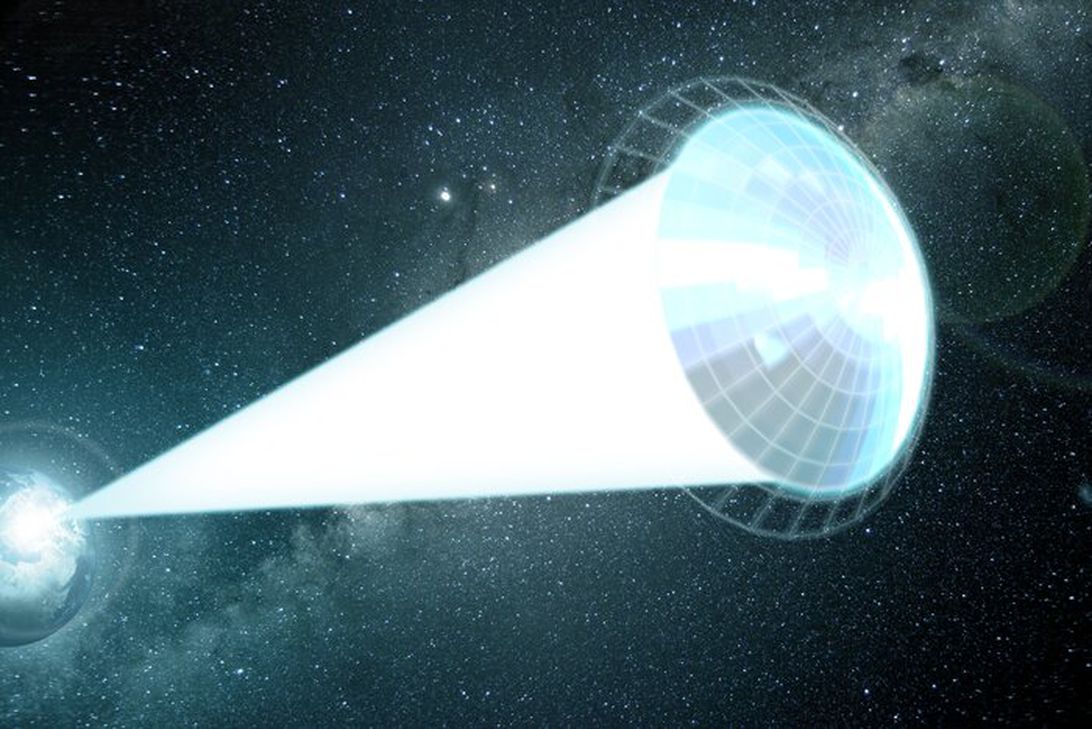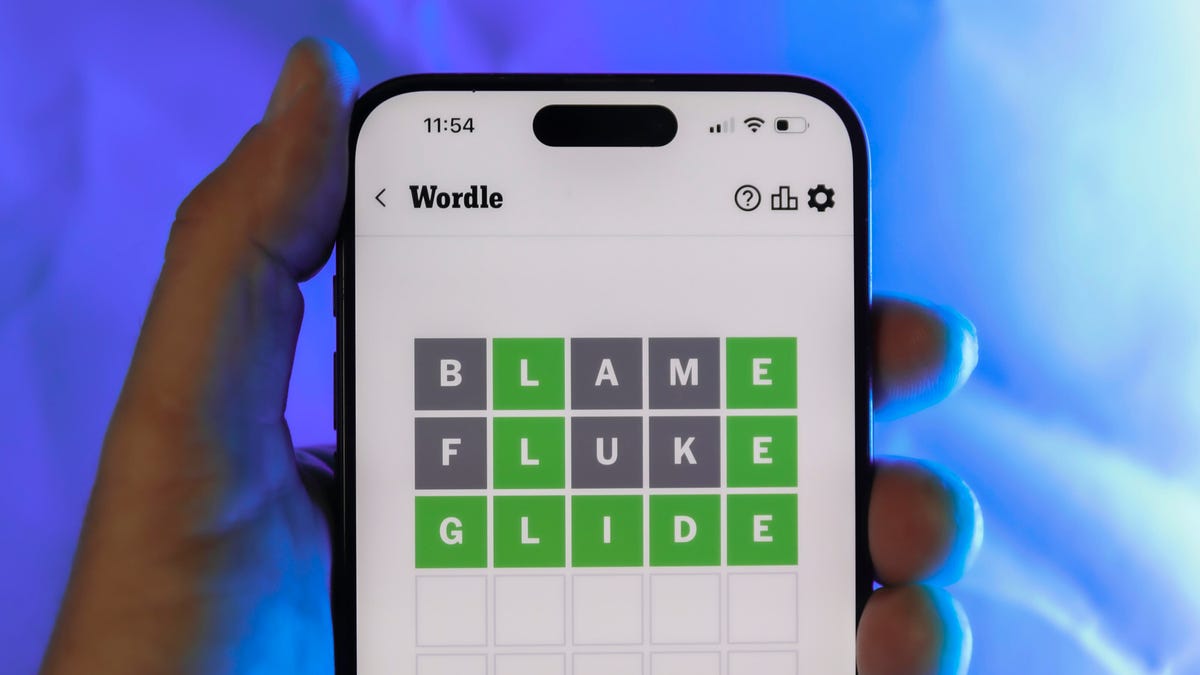Technologies
This Hyperspeed Space Sail Could Take Us to Next-Door Star Systems
For years, physicists have been trying to perfect a way to catapult space probes at a fifth the speed of light. One team is flagging an important section of the blueprint.

Only about 4 light-years away from our solar system lies Alpha Centauri, another bustling space neighborhood. It’s anchored by three stars with the same job as our sun, holds planets analogous to our eight famous orbs and may even have an Earth twin hanging out in the habitable zone. Almost like an alternate reality, the star system is a tantalizing region for space explorers.
There’s just one, glaring issue. With our present technology, spacecraft sent toward Alpha Centauri wouldn’t arrive until somewhere around the year 82022. That’s why, in 2016, late astrophysicist Stephen Hawking and investor Yuri Milner launched Breakthrough Starshot — an initiative to send microchip-size space probes over to Alpha Centauri at 20% the speed of light, reducing the whopping travel time to a mere 20 years.
Their blueprint centers on a lightsail that harnesses the power of photons, aka light particles, beamed from an Earth-based laser, instead of wind like a traditional sail. Though it’d fit right in with the sci-fi tech of Star Trek, the idea gained so much popularity that researchers everywhere began studying how to bring the contraption to fruition, hoping to produce a hyperdrive that blasts around the universe at dizzying rates.
Hailing from the University of Pennsylvania, one such team is tackling a big piece of the puzzle. In a pair of papers published this month in the journal Nano Letters, researchers suggested a way to ensure these innovative spacecraft don’t tear from intense laser pulses during the two-decade-long interstellar voyage. Basically, the researchers propose the sail must «billow» in space’s void like standard boat sails wave amid Earth’s winds.
«Some of the lightsail figures from early on were billowing, some were not, but it was not well studied,» said study author Igor Bargatin, an associate professor in the department of mechanical engineering and applied mechanics at the University of Pennsylvania. «What we did is show you definitely need billowing.
«We realized people haven’t really looked at the mechanics of the problem, and in particular, the possibility of tears,» Bargatinadded. «We want to make sure if and when this idea is realized, people pay attention to things that could happen during acceleration.
«We don’t want these sails to fail.»
Interstellar ship parameters
Picture a boat venturing out to sea with a sail attached. The sail will heave with every gust of wind and propel the vessel forward. That propulsion happens because wind hitting the sail bounces off, creating pressure.
Lightsails aren’t all that different.
«When the photons hit our lightsail, they get reflected and they also create pressure,» Bargatin said. «The exact mechanism is a little different because we’re talking light versus actual molecules of air. But they create pressure nonetheless in both cases.» In fact, these devices have already been proven effective to a degree.
In 2010, the Japanese Aerospace Exploration Agency launched a lightsail mission dubbed Ikaros and deemed it a success. In 2019, the experimental LightSail 2 followed suit. Funded by a Kickstarter campaign started by Bill Nye and Neil DeGrasse Tyson, it moved a small satellite in space using pure photon power.
But both Ikaros and LightSail 2 used light emanating from the sun, in contrast to Breakthrough Starshot’s vision of laser beams.
Though sunlight reduces the risk of tears, it’s too weak for Starshot’s endeavor. Plus, Bargatin says, Starshot light pulses must happen within a relatively short period of time because once the lightsail gets too far from Earth, scientists lose their ability to effectively accelerate it.
In short, to reach a fifth the speed of light — so it can access Alpha Centauri in the desired 20 years — within a strict window, lightsails would need extremely strong light pulses possible only with lasers.
«Designed pressures on our lightsails are not huge,» Bargatin said. «They’re about the same as having a penny on your hand.» In scientific terms, the pressure adds up to about 10 pascals, Bargatin says, but consider how we go about our lives without worrying about light pressure at all.
Ten Pascals of light force requires a significant amount of laser power, so unlike Ikaros’ dance with wispy sunrays, lightsails imparted with ultra harsh laser pulses can be badly damaged.
How to build a durable lightsail
According to the researchers, strong laser pulses could create pressure forceful enough to curve and tear the sheet like a taut boat sail may rip if hit by a giant gust of wind.
They believe lightsails must have the ability to «billow» and form a curved shape kind of like a parachute. Both the sail’s length and the radius of curvature, Bargatin explains, should be about 3 meters. In their new papers, the authors outline geometric measurements that ensure optimal billowing.
Even a lightsail protected from tears, however, will encounter other obstacles. To overcome such issues, the major parameter to consider is sail material. The sheets must be strong for durability, lightweight to minimize laser strength, reflect light efficiently for ideal propulsion and shed heat generated from laser pulses.
If the latter bit isn’t taken care of, Bargatin says, the sail could literally melt in space.
«You can come up with a combination of materials. The thicknesses of those materials and curved geometries would allow the sail to survive the pressures that we’re currently designing for,» Bargatin said, noting his team is mostly looking at a material called molybdenum disulfide.
In the grand scheme of things, though, building the massive laser array that’ll beam lightsails forward will be a big hurdle. Researchers working in space-based communication, Bargatin says, are also still figuring out how to retrieve information from the microchip probe attached to the lightsail.
If Breakthrough Starshot’s mechanism works one day, it’ll be a true testament to humanity’s brilliance in the field of science. In an announcement of the organization’s immense goals six years ago, Hawking stated:
«I believe what makes us unique is transcending our limits. Gravity pins us to the ground, but I just flew to America. I lost my voice, but I can still speak, thanks to my voice synthesizer. How do we transcend these limits?
«With our minds and our machines.»
Technologies
Today’s NYT Mini Crossword Answers for Wednesday, Dec. 24
Here are the answers for The New York Times Mini Crossword for Dec. 24.

Looking for the most recent Mini Crossword answer? Click here for today’s Mini Crossword hints, as well as our daily answers and hints for The New York Times Wordle, Strands, Connections and Connections: Sports Edition puzzles.
Need some help with today’s Mini Crossword? I’m Irish-American, but yet 6-Down, which involves Ireland, stumped me at first. Read on for all the answers.. And if you could use some hints and guidance for daily solving, check out our Mini Crossword tips.
If you’re looking for today’s Wordle, Connections, Connections: Sports Edition and Strands answers, you can visit CNET’s NYT puzzle hints page.
Read more: Tips and Tricks for Solving The New York Times Mini Crossword
Let’s get to those Mini Crossword clues and answers.
Mini across clues and answers
1A clue: Wordle or Boggle
Answer: GAME
5A clue: Big Newton
Answer: ISAAC
7A clue: Specialized vocabulary
Answer: LINGO
8A clue: «See you in a bit!»
Answer: LATER
9A clue: Tone of many internet comments
Answer: SNARK
Mini down clues and answers
1D clue: Sharks use them to breathe
Answer: GILLS
2D clue: From Singapore or South Korea, say
Answer: ASIAN
3D clue: Large ocean ray
Answer: MANTA
4D clue: ___ beaver
Answer: EAGER
6D clue: Second-largest city in the Republic of Ireland, after Dublin
Answer: CORK
Don’t miss any of our unbiased tech content and lab-based reviews. Add CNET as a preferred Google source.
Technologies
Quadrantids Is a Short but Sweet Meteor Shower Just After New Year’s. How to See It
This meteor shower has one of the most active peaks, but it doesn’t last for very long.

The Quadrantids has the potential to be one of the most active meteor showers of the year, and skygazers won’t have long to wait to see it. The annual shower is predicted to reach maximum intensity on Jan. 3. And with a display that can rival Perseids, Quadrantids could be worth braving the cold to see it.
Don’t miss any of our unbiased tech content and lab-based reviews. Add CNET as a preferred Google source.
The show officially begins on Dec. 28 and lasts until Jan. 12, according to the American Meteor Society. Quadrantids is scheduled to peak on Jan. 2-3, when it may produce upwards of 125 meteors per hour. This matches Perseids and other larger meteor showers on a per-hour rate, but Quadrantids also has one of the shortest peaks at just 6 hours, so it rarely produces as many meteors overall as the other big ones.
The meteor shower comes to Earth courtesy of the 2003 EH1 asteroid, which is notable because most meteor showers are fed from comets, not asteroids. Per NASA, 2003 EH1 is a near-Earth asteroid that orbits the sun once every five and a half years. Science posits that 2003 EH1 was a comet in a past life, but too many trips around the sun stripped it of its ice, leaving only its rocky core. The Earth runs through EH1’s orbital debris every January, which results in the Quadrantids meteor shower.
How and where to see Quadrantids
Quadrantids is named for the constellation where its meteors appear to originate, a point known as the radiant. This presents another oddity, as the shower originates from the constellation Quadrans Muralis. This constellation ceased to be recognized as an official constellation in the 1920s and isn’t available on most publicly accessible sky maps.
For the modern skygazer, you’ll instead need to find the Bootes and Draco constellations, both of which contain stars that were once a part of the Quadrans Muralis. Draco will be easier to find after sunset on the evening of Jan. 2, and will be just above the horizon in the northern sky. Bootes orbits around Draco, but will remain under the horizon until just after 1 a.m. local time in the northeastern sky. From that point forward, both will sit in the northeastern part of the sky until sunrise. You’ll want to point your chair in that direction and stay there to see meteors.
As the American Meteor Society notes, Quadrantids has a short but active peak, lasting around 6 hours. The peak is expected to start around 4 p.m. ET and last well into the evening. NASA predicts the meteor shower to start one day later on Jan. 3-4, so if you don’t see any on the evening of Jan. 2, try again on Jan. 3.
To get the best results, the standard space viewing tips apply. You’ll want to get as far away from the city and suburbs as possible to reduce light pollution. Since it’ll be so cold outside, dress warmly and abstain from alcoholic beverages, as they can affect your body temperature. You won’t need any binoculars or telescopes, and the reduced field of view may actually impact your ability to see meteors.
The bad news is that either way, the Quadrantids meteor shower coincides almost perfectly with January’s Wolf Moon, which also happens to be a supermoon. This will introduce quite a lot of light pollution, which will likely drown out all but the brightest meteors. So, while it may have a peak of over 100 meteors per hour, both NASA and the AMS agree that the more realistic expectation is 10 or so bright meteors per hour.
Technologies
Today’s Wordle Hints, Answer and Help for Dec. 24, #1649
Here are hints and the answer for today’s Wordle for Dec. 24, No. 1,649.

Looking for the most recent Wordle answer? Click here for today’s Wordle hints, as well as our daily answers and hints for The New York Times Mini Crossword, Connections, Connections: Sports Edition and Strands puzzles.
Today’s Wordle puzzle is a little tricky, with a double letter that could confuse players. If you need a new starter word, check out our list of which letters show up the most in English words. If you need hints and the answer, read on.
Read more: New Study Reveals Wordle’s Top 10 Toughest Words of 2025
Today’s Wordle hints
Before we show you today’s Wordle answer, we’ll give you some hints. If you don’t want a spoiler, look away now.
Wordle hint No. 1: Repeats
Today’s Wordle answer has one repeated letter.
Wordle hint No. 2: Vowels
Today’s Wordle answer has one vowel, but it’s the repeated letter, so you’ll see it twice.
Wordle hint No. 3: First letter
Today’s Wordle answer begins with S.
Wordle hint No. 4: Last letter
Today’s Wordle answer ends with L.
Wordle hint No. 5: Meaning
Today’s Wordle answer can refer to a cylindrical device upon which thread is wound.
TODAY’S WORDLE ANSWER
Today’s Wordle answer is SPOOL.
Yesterday’s Wordle answer
Yesterday’s Wordle answer, Dec. 23, No. 1648 was GLINT.
Recent Wordle answers
Dec. 19, No. 1644: MYRRH
Dec. 20, No. 1645: WHITE
Dec. 21, No. 1646: QUILT
Dec. 22, No. 1647: CONCH
Don’t miss any of our unbiased tech content and lab-based reviews. Add CNET as a preferred Google source.
-

 Technologies3 года ago
Technologies3 года agoTech Companies Need to Be Held Accountable for Security, Experts Say
-

 Technologies3 года ago
Technologies3 года agoBest Handheld Game Console in 2023
-

 Technologies3 года ago
Technologies3 года agoTighten Up Your VR Game With the Best Head Straps for Quest 2
-

 Technologies4 года ago
Technologies4 года agoBlack Friday 2021: The best deals on TVs, headphones, kitchenware, and more
-

 Technologies4 года ago
Technologies4 года agoVerum, Wickr and Threema: next generation secured messengers
-

 Technologies4 года ago
Technologies4 года agoGoogle to require vaccinations as Silicon Valley rethinks return-to-office policies
-

 Technologies4 года ago
Technologies4 года agoOlivia Harlan Dekker for Verum Messenger
-

 Technologies4 года ago
Technologies4 года agoiPhone 13 event: How to watch Apple’s big announcement tomorrow
